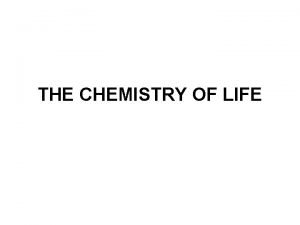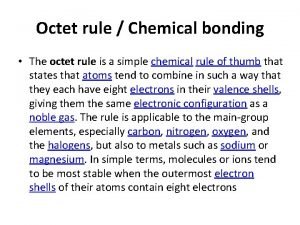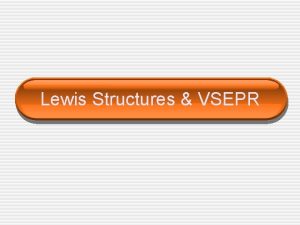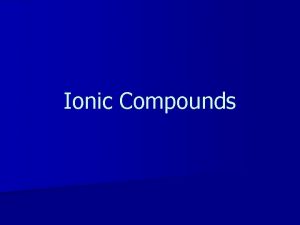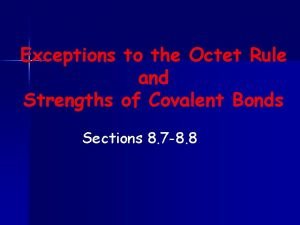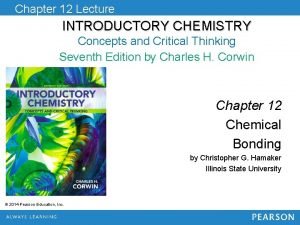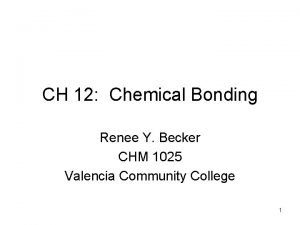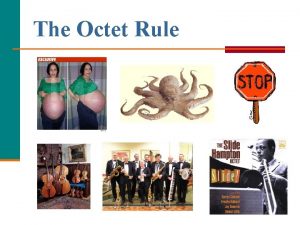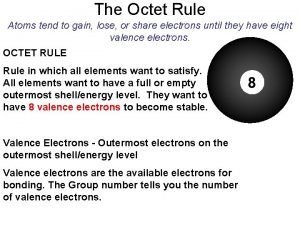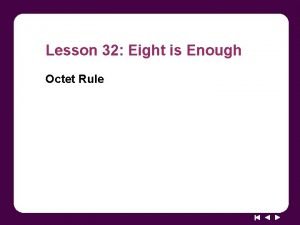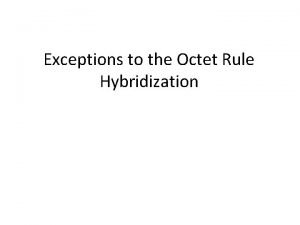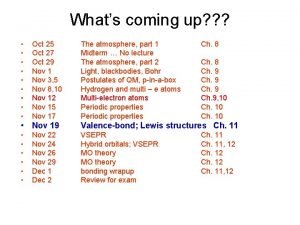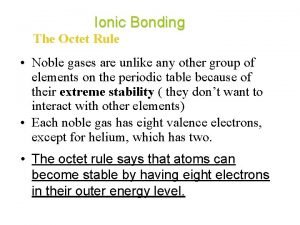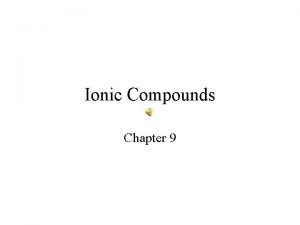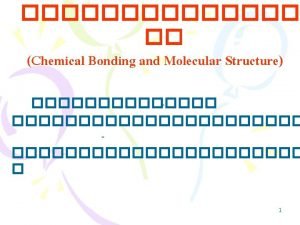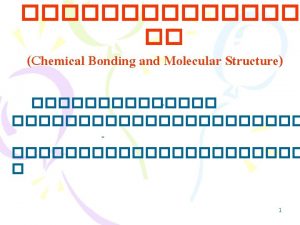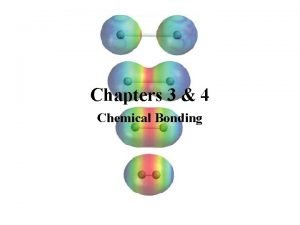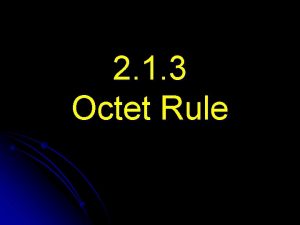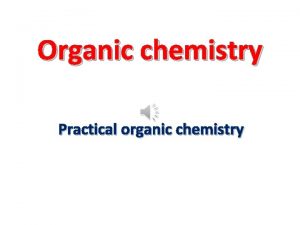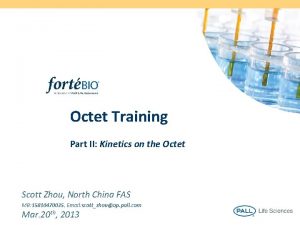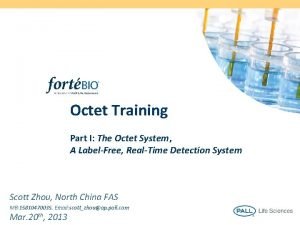Organic chemistry Welcome Questions 1 octet rule Lewis



































- Slides: 35

Organic chemistry Welcome

Questions • • • 1. octet rule Lewis dot structures Covalent bond In which main group do you find carbon? Electronegativity

Electronegativity • See p. 85 -86

Where to go for informations: • Milne. ruc. dk/kemikurser/Chemistry. B • Bookmark this page

Aim Learn simple organic chemistry Learn how to interpret names Be familiar with chemical reactions Build a fundament for understanding more complex structures such as biomolecules • Be able to relate organic chemistry to daily day life • •

Organic chemisty • Wöhler • Organic chemisty is carbon chemistry

Allosteric forms of carbon

10. 1 The Chemistry of Carbon Comparison of Major Properties of Organic and Inorganic Compounds

10. 1 The Chemistry of Carbon Division of the Family of Hydrocarbons

10. 1 The Chemistry of Carbon Hydrocarbon Saturation • Alkanes are compounds that contain only carbon-carbon and carbon-hydrogen single bonds – A saturated hydrocarbon has no double or triple bonds • Alkenes and alkynes are unsaturated because they contain at least one carbon to carbon double or triple bond

10. 1 The Chemistry of Carbon Cyclic Structure of Hydrocarbons • Some hydrocarbons are cyclic – Form a closed ring – Aromatic hydrocarbons contain a benzene ring or related structure

10. 1 The Chemistry of Carbon Common Functional Groups

10. 2 Alkanes Names and Formulas of the First Ten Straight-Chain Alkanes

10. 2 Alkanes The Tetrahedral Carbon Atom (a) Lewis dot structure (b) The tetrahedral shape around the carbon atom (c) The tetrahedral carbon drawn with dashes and wedges (d) The stick drawing of the tetrahedral carbon atom (e) Ball and stick model of methane

10. 2 Alkanes Drawing Methane and Ethane Staggered form of ethane

VSEPR • Valence shell electron pair repulsion • Principle: arrange atoms so negatively charged parts are as far from each other as possible

10. 2 Alkanes Comparison of Ethane and Butane Structures

Comparison of Physical Properties of Five Isomers of Hexane

10. 2 Alkanes Names and Formulas of the First Five Alkyl Groups

10. 2 Alkanes Alkyl Group Classification • Alkyl groups are classified according to the number of carbons attached to the carbon atom that joins the alkyl group to a molecule • All continuous chain alkyl groups are 1º • Isopropyl and sec-butyl are 2º groups

10. 2 Alkanes Structures and Names of Some Branched. Chain Alkyl Groups

10. 2 Alkanes Carbon Chain Length and Prefixes

IUPAC Names for Alkanes 6 10. 2 Alkanes 1. The base or parent name for an alkane is determined by the longest chain of carbon atoms in the formula – The longest chain may bend and twist, it is seldom horizontal – Any carbon groups not part of the base chain are called branches or substituents – These carbon groups are also called alkyl groups

IUPAC Names for Alkanes 10. 2 Alkanes 2. Number the carbon atoms in the chain starting from the end with the first branch – If both branches are equally from the ends, continue until a point of difference occurs

IUPAC Names for Alkanes 10. 2 Alkanes 3. Write each of the branches/substituents in alphabetical order before the base/stem name (longest chain) – Halogens usually come first – Indicate the position of the branch on the main chain by prefixing its name with the carbon number to which it is attached – Separate numbers and letters with a hyphen – Separate two or more numbers with commas

IUPAC Names for Alkanes • Hyphenated and number prefixes are not considered when alphabetizing groups – Name the compound below 10. 2 Alkanes – 5 -sec-butyl-4 -isopropylnonane

IUPAC Names for Alkanes • When a branch/substituent occurs more than once 10. 2 Alkanes – Prefix the name with • di • tri • tetra – Then list the number of the carbon branch for that substituent to the name with a separate number for each occurrence • Separate numbers with commas • e. g. , 3, 4 -dimethyl or 4, 4, 6 -triethyl

Cycloalkane Structures 10. 3 Cycloalkanes Cyclopropane Cyclobutane Cyclohexane Type of Formula: Structural Condensed Line

10. 3 Cycloalkanes cis-trans Isomers in Cycloalkanes • Two groups may be on the same side (cis) of the imagined plane of the cycloring or they may be on the opposite side (trans) • Geometric isomers do not readily interconvert, only by breaking carbon-carbon bonds can they interconvert

10. 4 Conformations of Alkanes • Conformations differ only in rotation about carbon-11 carbon single bonds • Two conformations of ethane and butane are shown – The first (staggered form) is more stable because it allows hydrogens to be farther apart and thus, the atoms are less crowded

10. 4 Conformations of Alkanes and Cycloalkanes Two Conformations of Cyclohexane 11 Chair form (more stable) E = equatorial Boat form A = axial

10. 5 Reactions of Alkanes Alkane Reactions The majority of the reaction of alkanes are combustion reactions – Complete CH 4 + 2 O 2 CO 2 + 2 H 2 O Complete combustion produces – Carbon dioxide and water – Incomplete 2 CH 4 + 3 O 2 2 CO + 4 H 2 O • Incomplete combustion produces – Carbon monoxide and water – Carbon monoxide is a poison that binds irreversibly to red blood cells

10. 5 Reactions of Alkanes Halogenation is a type of substitution reaction, a reaction that results in a replacement of one group for another – Products of this reaction are: • Alkyl halide or haloalkane • Hydrogen halide – This reaction is important in converting unreactive alkanes into many starting materials for other products – Halogenation of alkanes ONLY occurs in the presence of heat and/or light (UV)

10. 5 Reactions of Alkanes Petroleum Processing Fraction Boiling Pt Range ºC Carbon size Typical uses Gas -164 -30 C 1 -C 4 Heating, cooking Gasoline 30 -200 C 5 -C 12 Motor fuel Kerosene 175 -275 C 12 -C 16 Fuel for stoves, diesel and jet engines Heating oil Up to 375 C 15 -C 18 Furnace oil Lubricating 350 and up oil C 16 -C 20 Lubrication, mineral oil Greases Semisolid C 18 -up Lubrication, petroleum jelly Paraffin (wax) Melts at 52 -57 C 20 -up Candles, toiletries Pitch / tar Residue in boiler High Roofing, asphalt paving

Chloroform Halothane CF 3 CHBr. Cl Freons Artificial blood, perfluorodecalin 50% oxygen
 Ib chemistry functional groups
Ib chemistry functional groups Organic vs inorganic chemistry
Organic vs inorganic chemistry Expanded octet lewis structure
Expanded octet lewis structure The octet rule states that
The octet rule states that The octet rule states that
The octet rule states that Metoda vsepr
Metoda vsepr Mono di tri tetra penta hexa
Mono di tri tetra penta hexa Valence electrons for transition metals
Valence electrons for transition metals Exceptions to the octet rule
Exceptions to the octet rule The octet rule states that
The octet rule states that The octet rule states that
The octet rule states that Mg octet rule
Mg octet rule Aluminum chloride charge
Aluminum chloride charge Eight is enough octet rule lesson 32
Eight is enough octet rule lesson 32 Hybridization exceptions
Hybridization exceptions Whats the octet rule
Whats the octet rule Octet rule noble gases
Octet rule noble gases Horizontal row in the periodic table
Horizontal row in the periodic table Numbering carbon chains
Numbering carbon chains Chemistry of soap making
Chemistry of soap making Ester organic chemistry
Ester organic chemistry Nonene
Nonene Rearranged most stable carbocation is
Rearranged most stable carbocation is Ee organic chemistry
Ee organic chemistry Ario organic chemistry
Ario organic chemistry Thermodynamic vs kinetic control
Thermodynamic vs kinetic control Organic chemistry david klein 3rd edition
Organic chemistry david klein 3rd edition Klein organic chemistry 2nd edition
Klein organic chemistry 2nd edition Ario practice problems
Ario practice problems Organic chemistry naming
Organic chemistry naming Organic chemistry lab report format
Organic chemistry lab report format Www.masterorganicchemistry.com
Www.masterorganicchemistry.com Grade 10 organic chemistry
Grade 10 organic chemistry Organic chemistry
Organic chemistry Importance of organic compounds
Importance of organic compounds Organic chemistry wade
Organic chemistry wade



